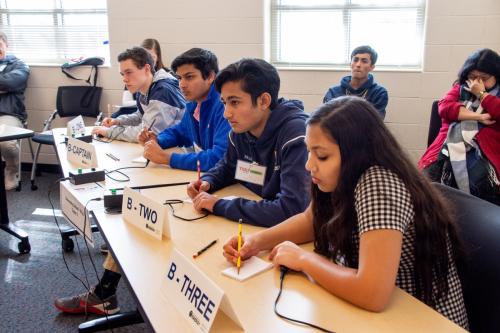“An education that does not provide access to literacy cannot be called an education at all,” claimed the lawsuit Ella T. vs. the State of California in its 2017 filing. As part of the lawsuit’s 2020 settlement, California allocated more than $50 million to improve literacy instruction in its lowest-performing schools through a program known as the Early Literacy Support Block Grant (ELSBG).
ELSBG incorporated evidence-based literacy instruction of concepts like phonics and vocabulary (a bundle sometimes called the “science of reading”) into its core, training teachers and staff at targeted schools in its methods. This push for the “science of reading” in schools is not unique to California. Thirty-two states and the District of Columbia have passed new reading laws in the last decade; many of the laws (such as those in Louisiana or Minnesota) required or encouraged teachers to receive training in these concepts.
ELSBG is unusual, though, in that it created an environment for implementation that went far beyond teacher training or curricular purchases. In addition to those components, ELSBG allocated about $1,000 per student and allowed principals broad autonomy to choose the expenditures that would best help their students. Principals also consulted with the state-designated Expert Lead in Literacy to design these action plans and budgets.
My new research with co-author Thomas S. Dee after the program’s first two years of implementation shows that it had broad success. ELSBG increased the share of students scoring Level 2 or higher (Standard Nearly Met, Standard Met, or Standard Exceeded) on English Language Arts tests by 6 percentage points (a 20% increase). We also show that ELSBG increased the mean ELA test score of students by 0.14 standard deviations (SD) and had a spillover effect on math scores, increasing the mean test score of targeted students by 0.11 SD.
What is the “Science of Reading?”
In 2000, the National Reading Panel authored a report commissioned by the United States Congress. After a review of more than 100,000 studies, the authors identified five pillars of optimal reading instruction:
- Phonemic awareness, or the ability to listen for and identify component sounds (phonemes) within a word;
- Phonics instruction, or the teaching of the relationship between individual letters (or letter pairs) and their sounds;
- Fluency, or a child’s ability to read accurately and smoothly;
- Vocabulary building, through teaching the meaning of particular words directly or building skills to determine word meaning from context or word structure;
- Comprehension-building strategies, like teaching to summarize.
The “science of reading” implements those five pillars in classroom practice. It contrasts with a whole language approach still used in many schools. Whole language relies on the idea that students will learn to read if they are surrounded by reading and reading is made fun. Whole language also emphasizes words in their context; in addition to sounding out an unfamiliar word, children are encouraged to look to nearby words or pictures for clues about what might make sense in the sentence (a process known as “three cueing”).
With growing enthusiasm for the “science of reading” and concerns about whole language approaches—spurred recently by the podcast “Sold a Story”—state policymakers have increasingly passed laws encouraging the adoption of science of reading methods. While these initiatives have shown promise in descriptive analyses, like those in Mississippi and Michigan, rigorous causal designs are scarce. An evaluation of California’s recent initiative therefore provides an important opportunity.
Pairing “science of reading” with targeted spending, autonomy, and oversight
As described earlier, California’s state initiative—the Early Literacy Support Block Grant (ELSBG) —is especially notable for pairing a science of reading emphasis with a few notable design features.
First, schools received about $1,000 per student. Funding was required to “supplement, not supplant” existing activities and only allowed to be spent on the targeted grades of K-3 and on literacy specifically.
Second, ELSBG paired this targeted funding with support, as the state chose the Sacramento County Office of Education (SCOE) to serve as the “Expert Lead in Literacy.” SCOE helped schools determine where to spend their funds, and it hosted thousands of hours of optional and free online “science of reading” professional development for teachers, administrators, and district leads. Though sessions were optional, an average of 58 ELSBG schools attended each session and school staff reported high levels of satisfaction with the trainings provided.
Third, though ELSBG schools received assistance in budgeting, the schools themselves maintained ultimate authority to budget the new funds. They could spend these funds within broad categories of possible literacy improvements, such as new instructional coaches, professional development, curricula, and parental outreach.
After collecting budgets from all 35 funded districts or charter management organizations, we found that districts allocated 69% of the money to be spent on staffing, with other large categories going towards instructional materials or professional development. For example, at Calabasas Elementary in Watsonville, schools paid a Curriculum Coach and a Parent Engagement Specialist. This literacy curriculum coach trained staff on phonemic awareness while the Parent Engagement Specialist organized a Family Literacy Night. At Franklin McKinley Elementary in San Jose, the school used the grant to hire a part-time literacy coach who met with teachers weekly to “support developing word recognition scope and sequence and instructional guidelines” and led professional development.
In other words, schools overwhelmingly followed state law and used ELSBG to enhance K-3 literacy instruction. The “science of reading” character of instruction varied by school site, but budgets largely reflected an emphasis on training and supporting teachers in that model of instruction. Other expenditures were permitted though, with some schools investing in more generalized literacy support.
What kinds of effects did this program achieve?
Using state data and quasi-experimental methods, we use a synthetic difference-in-differences approach to analyze the effects of the program. In doing so, we compare test scores for ELSBG-eligible schools to test scores for similar schools across the same time period. We show that ELSBG substantially improved the reading performance of targeted students. It improved the percentage of students scoring at or above Standard Nearly Met by 20%, at or above Standard Met by 42%, and at Standard Exceeded by 59%. We also show that ELSBG increased the mean English Language Arts test score of students by 0.14 SD.
ELSBG’s test score gain of 0.14 SD on ELA test scores can be considered medium when compared to other educational programs and above the 80th percentile for programs with more than 2,000 students. ELSBG achieved these results with $1,144 per student spent in its first year, a much greater effect size to dollar ratio than the average $1,000 increase in per pupil school spending.
We apply the same procedure to grade 3 math scores to determine if this literacy-focused intervention had spillover effects on performance in other subjects. We find that the program improved math test scores by 0.11 SD. This positive effect may be due to strengthened student confidence or improvements in general elementary teacher instructional techniques like engagement, among other possibilities.
A path forward
These findings suggest that well-designed policy interventions, pairing the science of reading with notable design features like support and targeted funding, can be effective in improving academic achievement. Notably, too, these improvements can come quickly; we found improvements after only the first year of implementation. Furthermore, ELSBG was implemented during the COVID-19 pandemic in California’s lowest-performing schools, suggesting that its blueprint can be a model for other schools struggling with learning loss and attendance challenges ensuing from the pandemic.
As other states contemplate ways to implement shifts to the science of reading, these results should encourage them and suggest a way forward by accompanying changes to curriculum and teacher preparation with financial investments and support.







